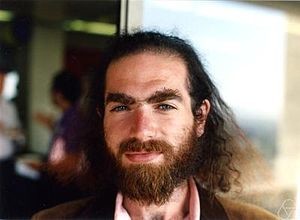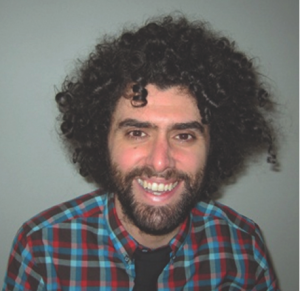
Russian mathematician, Grigori Yakovievich Perelman was born in Leningrad, Soviet Union in 1966. Perelman’s contributions to mathematics are vast and also noted despite his reluctance in accepting any recognition. In 1991 Perelman accepted a prize from the Saint Petersburg Mathematical Society. In 1994 Perelman developed a proof for the soul conjecture. Perelman truly exemplifies the less sought persona of mathematicians purporting to love math unconditional of monetary gain, fame or recognition. A slightly younger mathematician of our day practices math skill and public speaking simultaneously representing Australia as their numeracy ambassador. Simon Pampena similarly personifies his love for math by making a spectacle of his self while serving as a mathematic advocate. Both these men posses a strong math skill in addition to lifestyles that portray high favor of mathematical usage or comprehension.
(Perelman left, Pampena right)
Since accepting the prize in 1991, Perelman has declined all other rewards for his proofs. A brief example is illustrated in 2002 when the Thurston’s geometrization conjecture was proven by Perelman, subsequently confirming in the affirmative the Poincare conjecture posed in 1904. Poincare’s conjecture for the longest time was considered one of the most important problems in topology. Poincare’s conjecture is seemingly esoteric intrinsically difficult to understand. Simon Pampena, who also doubles as a standup comedian, is seen on an ABC science special called “Catalyst” in early 2007. Pampena uses his communication skill to clarify and demonstrate the concept behind the conjecture in a very simplistic fashion using props as necessary. Contrary to Perelman’s reclusive nature Pampena doesn’t seem to mind the lime light. Unfortunately Pampena is unable be to linked to any Wikipedia pages, which he personally shared as being attributed to his lack of academic pursuit post graduate.
Post graduation, Perelman took work as at the prestigious Leningrad Department of Steklov Institute of Mathematics. Perelman has been receiving recognition in the field of mathematics since he was a teenager. Born to Jewish parents, Grigori’s mathematical talent began to shine at age ten for him. About age 24 Perelman was a researcher at many universities in the United States, beginning work in New York on “manifolds with lower bounds on Ricci curvature” (Wiki). Since his discovery in 1994 many top universities began knocking on Perelman’s door with job offers. Princeton, Stanford were among esteemed colleges but Perelman turned both down, and returned to his home in Saint Petersburg in the hot of 1995. In 2003 Perleman accepted invitation to several universities in the states where he gave lectures regarding his outlined proof of the geometrization conjecture specifically encompassing the famous Poincare Conjecture.
In a recent interview the extremely charismatic, Simon Pampena reveals, “Comedy’s best effect on science will be to increase communication. The more levels of society that engage with maths and science, the better these disciplines will be. There are sports-mad people all over the world who don’t have a hope at playing the game competitively themselves. Just because someone can’t do maths or science themselves shouldn’t stop them enjoying it and the easiest way to enjoy an intellectual subject is through comedy.”
Simon Pampena goes on to share via email correspondence that he is currently enjoying American hospitality in sunny California working on a film. Going from a college graduate to statistician in the industry, to now, a mathematical comedian. He has performed several science and comedic festivals as well as a tour for national science week, years 2007-2011. Numbercrunch is an audiovisual set that Pampena performs for high schools and colleges alike promoting and suggesting positive outlooks toward math.
Meanwhile what has made Grigori Yakovievich Perelman extremely popular with the media is not so much his math work, but his unwillingness to accept various prizes from many organizations. In a 2006 interview, Perelman was jobless, leaving his work at Steklov Institute in the spring of 2003. It was in the same 2006 interview Perelman was reported to living with his mother in Saint Petersberg. According to friends of Grigori, math has become a painful topic to discuss. In an effort to not be prodded by the media Dr. Perelman has been quoted saying tings to the press such as, “I have all I want.” “I’m not interested in money or fame…I don’t want to be on display like an animal in a zoo. I’ not a hero of mathematics, I’m not even that successful; that is why I don’t want to have everybody looking at me.”
Success or lack-there-of Perelman has acquired a considerable amount of attention. As Dr. Perelman turned down two major awards, both organizations eager to and willing to deliver the equivalent of one million US dollars to the Perelman for his mathematical contributions. From the US Clay Mathematics Institute, to the Fields Medal the highest award in mathematics as well as the noble prize equivalent. Perelman has even gone as far as deflecting his discoveries to having less significance than that of Richard Hamilton (a U.S. mathematician at Columbia University, who introduced Ricci Flow).
Finally, what is so mathematically important about Poincares Conjecture that it would warrant several prizes of monetary or social compensation? In the most laymen of terms, Henri Poincare of the 20th century, purposed that a 3-sphere (like a tennis ball), is the most simple object to exist in four dimensional space. A conjecture of the ages purposed in 1904, that would perplex mathematicians for almost 100 years. Now topological courses relay on new proofs recently submitted. Even the proofs get reviewed in what took Perelman 3 years to have cross-examined by a board. His verified assertion has paved the way for understanding in a more practical applied theory, the nature of our universe and how it may have been formed. It also explains why topologist cannot tell their homeomorphic coffee cup from their homeomorphic donut {a joke that Simon Pampena would surely appreciate}.
Quite clearly these two men have something in common and that is their strong math ability and comprehension. It would be terribly redolent to compare Perelman and Pampena in any regard other than math sense, but it does not go unnoticed consideration Pampena seems to have for the global public and youth. Perelman continues to refuse the million dollar prizes despite suggestions and urges from third parties for him to donate to charities. More than public image this author has learned a bit about communication. The math is a bit over my head, but it is encouraging to know that math will continue to surprise amaze and ask of me. I look forward to the day that I can solve my own conjecture, or perhaps submit my own.


